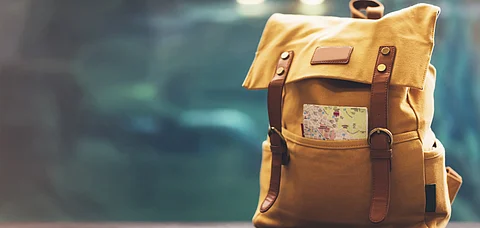
- Destinations
- Experiences
- Stay
- What's new
- Editor’s Picks
- Responsible Tourism
- CampaignsCampaigns
- Subscribe

Whether it is a simple trek, a two-day journey or even just a visit to the nearby market, many are sure to carry one thing (besides a phone and money, of course) and that is the trust old backpack. Practical and even a fashion statement nowadays, the backpack has gone through a tedious history, setting us back over a century. What we know of out backpacks now - colourful, stylish, multi-purpose, some even smart- hardly has any resemblance to the conceptual piece.
It all began with the need to carry items from point A to point B. A couple of centuries ago, people accomplished this fete by tying their belongings in simple cloth sacks hung over their shoulders. It wasn&rsquot until 1878 that the backpack saw any innovation. Henry Merriam patented the &lsquoknapsack&rsquo that year. His backpack was supported by a metal frame that did not require any straps. This, he believed, would help reduce the burden on people&rsquos backs and help them move freely. However, the thought did not materialise and the use of it soon came to an end. The &lsquoknapsack&rsquo was made exclusively for the US Army.
Returning from a hunting trip with sore shoulders in 1908, Norwegian inventor Ole Bergan decided to create a design that did not compromise on the comfort of the wearer. Initially, he bent a piece of juniper wood to replicate the contours of a person&rsquos back on which a soft cloth bag was hung. The creation was later improved by replacing the wooden frame with light tubular steel. This revolutionary technique became popular and was patented for 25 years.
Not much later in 1920, Lloyd Nelson redesigned his backpack post a visit to Alaska. The locals of Alaska used wood and sealskin bags that later became the inspiration for Nelson&rsquos model. Canvas bands were attached to a wooden frame on which hung cloth bags. Steel pins were used as attachment, making the bag easy to detach. This was known as the &lsquoTrapper bag&rsquo, which went on to become one of the first mass-produced bags in the world.
History was made when Gerry Cunningham introduced the first bag with zippers in 1938. Bear in mind that in those days, backpacks were owned by those who indulged in adventurous activities- hiking, rock climbing, camping. An ardent participant in rock climbing himself, Cunningham (who founded outdoor equipment company Fjallraven) built a prototype of a backpack that would allow the wearer to access their belongings easily.
Tired of the low-strung weight on his back, Ake Nordin, one day in 1950, returned from a mountain trek and built a canvas bag that was to be worn high and close to the back. He utilised his mother&rsquos sewing machine to build the prototype. It was built with a wooden frame and leather straps to fasten.
Revolution in the industry came in the name of Dick and Nina Kelty in 1952. With leftover material from World War II, the couple crafted large, lightweight bags. Surplus airplane aluminium was used as material for the frames and parachute material was sewn into soft covering. They also brought to the market contoured frames, waist straps and padded shoulder straps.
Greg Lowe is responsible for the first internal frame backpack. It was created in his garage in 1967. He recognised that the unstructured backpacks were not stable enough for large roads and rocky terrain. He created a pack flexible enough to contour and tough enough to carry heavy load. His product shifted the weight of the contents to the hip belt. Additionally, side compression straps and a sternum strap was added. This was the early image of what a modern backpack looks like.
Jumping back into the game in 1967, Gerry Cunningham produced the Teardrop backpack. This was a never-seen-before lightweight nylon bag. Only 3 years later, popular brand Jansport came out with the &lsquoSki and Hike&rsquo bag (another lightweight nylon daypack). It not only appealed to the adrenaline junkies, but also the everyday person.
Cut to today, backpacks have become as much a fashion statement as they are a functional product. In different shapes and sizes, backpacks now flood the market in various forms. We have the rucksacks, the everyday packs, the laptop bags and even the duffle backpacks. Some even come with innovative features such as slash-free material, smart backpacks and anti-theft locks.
